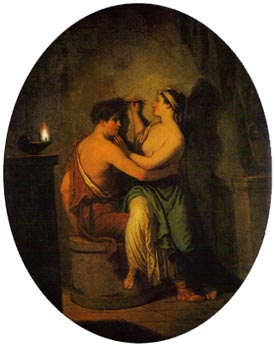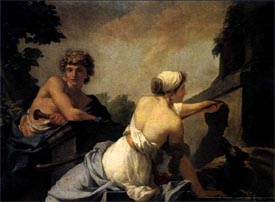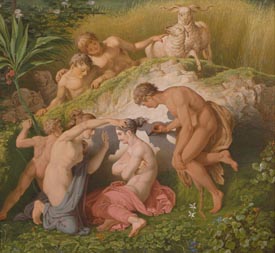DIBUTADES AND THE ORIGIN OF DRAWING
Francisco Martínez Mindeguía
|
|
According to a tradition from a story by Gaius Plinius Secundus (Pliny the Elder), the Roman writer of the first century A.D. (23-79), a potter’s daughter from Corinth, named Dibutades made the very first drawing. This girl had a beloved friend who was about to travel away from his city. Prior to his departure, the girl marked the contour of the boy’s head on a wall, following the shadow produced by a lamp’s light. She later asked her father to do a ceramic piece with this shape. This poetic image was famous in the 18th and 19th centuries, leading to many representations. One of them is the one on the left, by the painter David Allan, in 1773.
|
|
| David Allan, The origin of painting, 1773 |
|
Like all classical stories, improved in time, this one allows to understand well a specific conception of drawing, classical as well. It helps to illustrate the drawing containing life notes, but also the projected drawing (if the project was the design of the ceramic piece). It also works as a representation drawing, because the drawing was left on the wall afterwards. (The next image is a painting by Jean-Baptiste Regnault, in 1785) |
|
|
Probably, Dibutades’ daughter drew the shaded contour after lighting laterally the boy’s head, in order to keep his characteristic profile. The choice of this profile is almost as important as the fact of keeping it on the wall. The wall is the support, the proof that it does exist, but the selection is the drawing. A drawing is the selection of whatever is valued as well as the elimination of whatever is not interesting to show. |
|
| Jean-Baptiste Regnault, The origin of painting, 1785 |
(The next drawing is by the architect Karl Friedrich Schinkel, painted in 1830) |
|
|
Here, Schinkel changes the original idea, maybe because he is an architect: |
Recommended bibliography:
- Robert Rosenblum, "The Origin of Painting: A Problem in the Iconography of Romantic Classicism", The Art Bulletin, vol. 39, n. 4, 1957, pp. 279-290.
- George Levitine, Addenda to Robert Rosenblum, "The Origin of Painting: A Problem in the Iconography of Romantic Classicism", The Art Bulletin, vol. 40, n. 4, 1958, pp. 329-331.
-
Robin Evans, "Translations
From Drawings to Buildings", AA Files, 12, 1986, pp. 3-18.
-
Frances Muecke, ""Taught by Love": The Origin of Painting Again", The Art Bulletin, vol. 81, n. 2, 1999, pp. 297-302.
© of the texts Francisco Martínez Mindeguía
© by Ruth Costa Alonso, Francisco Martínez Mindeguía, and Antonio Millán: English translation
>> Back to the top of the page
>> Back to Dibujos Ejemplares de Arquitectura


